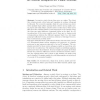Free Online Productivity Tools
i2Speak
i2Symbol
i2OCR
iTex2Img
iWeb2Print
iWeb2Shot
i2Type
iPdf2Split
iPdf2Merge
i2Bopomofo
i2Arabic
i2Style
i2Image
i2PDF
iLatex2Rtf
Sci2ools
ECCV
2010
Springer
2010
Springer
5D Motion Subspaces for Planar Motion
In practice, rigid objects often move on a plane. The object then rotates around a fixed axis and translates in a plane orthogonal to this axis. For a concrete example, think of a car moving on a street. Given multiple static affine cameras which observe such a rigidly moving object and track feature points located on this object, what can be said about the resulting feature point trajectories in the camera views? Are there any useful algebraic constraints hidden in the data? Is a 3D reconstruction of the scene possible even if there are no feature point correspondences between the different cameras? And if so, how many points are sufficient? Does a closed-form solution to this shape from motion reconstruction problem exist? This paper addresses these questions and thereby introduces the concept of 5 dimensional planar motion subspaces: the trajectory of a feature point seen by any camera is restricted to lie in a 5D subspace. The constraints provided by these motion subspaces enable...
| Added | 29 Sep 2010 |
| Updated | 29 Sep 2010 |
| Type | Conference |
| Year | 2010 |
| Where | ECCV |
Comments (0)

